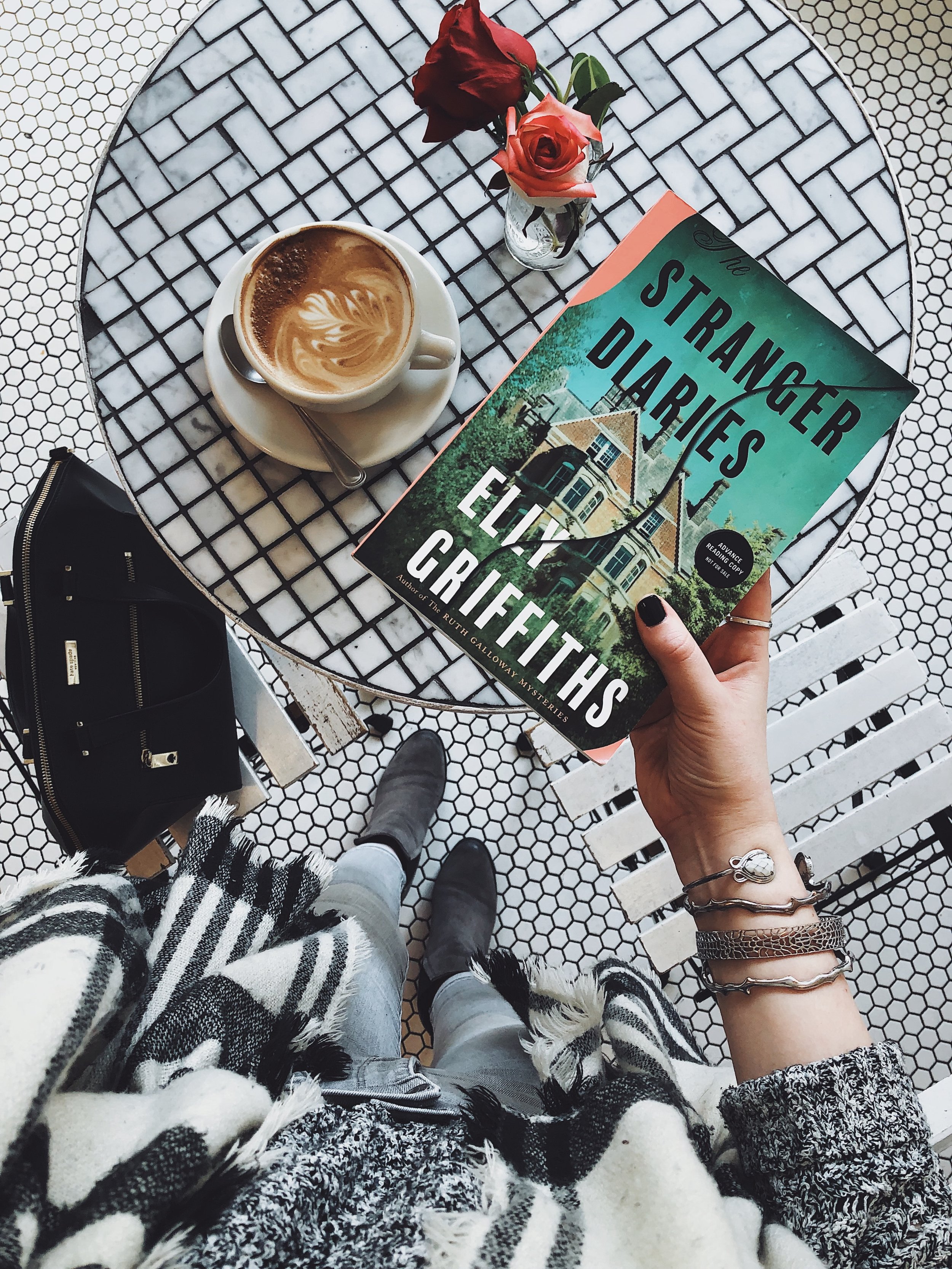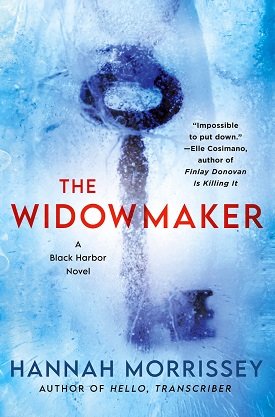Book Excerpt: THE STRANGER DIARIES by Elly Griffiths
Houghton Mifflin Harcourt | Available March 5th, 2019
A modern take on Gothic suspense with a literary twist? Sign me up. I first learned of Griffiths’ forthcoming standalone suspense novel THE STRANGER DIARIES at Bouchercon this past fall, and have been eagerly anticipating its release ever since. In THE STRANGER DIARIES, Griffiths (best known for her Ruth Galloway series) crafts a suspense novel centered around a teacher of Gothic literature, who finds the plot of one of the books she uses in her courses playing out in real life… to potentially deadly end. From its stunning cover to its bookish plot and Gothic-inspired touches, THE STRANGER DIARIES has all the makings of an instant-favorite for me - and I couldn’t be more excited to give you the inside scoop on this book today! Thanks to the team at Houghton Mifflin Harcourt, I’m thrilled to share with CBTB readers an early excerpt of the book’s first chapter. THE STRANGER DIARIES releases in the US in March, but you can get a taste of Griffiths’ captivating writing right here. And let me just say: I’m currently reading THE STRANGER DIARIES, and have found it to be absolutely gripping from page one. So far, it’s exceeding all my expectations, and I can’t wait for you to give it a read, too!
Many thanks to the team at HMH for providing an excerpt from Elly Griffiths’ THE STRANGER DIARIES for CBTB readers! Read on for plot details, a selection of the incredible early praise the book is already receiving, links to pre-order, and (of course!) the excerpt itself.
This post contains affiliate links. Crime by the Book is a participant in the Amazon Services LLC Associates Program, an affiliate advertising program designed to provide a means for sites to earn advertising fees by advertising and linking to Amazon.com. This in no way affects my opinion of the book featured here.
About the Book:
Clare Cassidy is no stranger to murder. A high school English teacher specializing in the Gothic writer R. M. Holland, she teaches a course on it every year. But when one of Clare’s colleagues and closest friends is found dead, with a line from R.M. Holland’s most famous story, “The Stranger,” left by her body, Clare is horrified to see her life collide with the storylines of her favorite literature.
To make matters worse, the police suspect the killer is someone Clare knows. Unsure whom to trust, she turns to her closest confidant, her diary, the only outlet she has for her darkest suspicions and fears about the case. Then one day she notices something odd. Writing that isn't hers, left on the page of an old diary:
Hallo Clare. You don’t know me.
Clare becomes more certain than ever: “The Stranger” has come to terrifying life. But can the ending be rewritten in time?
Early Praise for THE STRANGER DIARIES:
“Utterly bewitching. This atmospheric, intricate thriller, a pitch-perfect modern Gothic, chilled my blood and warmed my heart. As unforgettable as it is original.”
—A.J. Finn, #1 New York Times-bestselling author of The Woman in the Window
“My heart is still pounding after finishing Elly Griffiths’ The Stranger Diaries. As with her other books, this is fiercely intelligent, warm, human and at times, funny. But unlike her others, this is a stand-alone. Her first and I hope not her last. The Stranger Diaries picks up where the great Gothic thrillers of the past leave off. At once a homage to that great literary form, and a re-imagining. It is goose-bump spooky, smart, and haunting, in every sense. I loved this book! And you will too.”
—Louise Penny, #1 New York Times best-selling author of the Chief Inspector Armand Gamache mystery series
"A multi-layered and splendidly creepy gothic tale...Cliffhangers and gothic tropes abound as the narrative baton is passed between Clare, her daughter Georgia and the former Talgarth pupil DS Harbinder Kaur, with Griffiths expertly ratcheting up the tension."
—Guardian
"Griffiths has gifted readers with a gripping homage to the gothic novel...An entrancing literary tour de force in which Shakespeare’s line, 'Hell is empty,' from The Tempest, cleverly connects past and present. Georgette Heyer fans will relish this, as will readers who enjoyed Diane Setterfield’s The Thirteenth Tale and Anthony Horowitz’s Magpie Murders."
—Booklist, STARRED review
“The Stranger Diaries can be described in one word: delicious! Who could resist the gothic tale from the past, the spooky old school (so like those we all attended in England) all beautifully blended with very real and compelling characters in the present. Top marks to Miss Griffiths!”
—Rhys Bowen,New York Times-bestselling author of The Tuscan Child, In Farleigh Field and the Royal Spyness novels
“The Stranger Diaries is a gripping gothic thriller, with a wry, modern tone all its own. Griffiths writes here with the same sharp, compassionate understanding of how people work that has made her Ruth Galloway books so memorable. I couldn't put it down.”
—Flynn Berry, Edgar Award-winning author of Under the Harrow and A Double Life
Excerpt: THE STRANGER DIARIES
By Elly Griffiths
CHAPTER 1
‘If you’ll permit me,’ said the Stranger, ‘I’d like to tell you a story. After all, it’s a long journey and, by the look of those skies, we’re not going to be leaving this carriage for some time. So, why not pass the hours with some story-telling? The perfect thing for a late October evening.
Are you quite comfortable there? Don’t worry about Herbert. He won’t hurt you. It’s just this weather that makes him nervous. Now, where was I? What about some brandy to keep the chill out? You don’t mind a hip flask, do you?
Well, this is a story that actually happened. Those are the best kind, don’t you think? Better still, it happened to me when I was a young man. About your age.
I was a student at Cambridge. Studying Divinity, of course. There’s no other subject, in my opinion, except possibly English Literature. We are such stuff as dreams are made on. I’d been there for almost a term. I was a shy boy from the country and I suppose I was lonely. I wasn’t one of the swells, those young men in white bow ties who sauntered across the court as if they had letters patent from God. I kept myself to myself, went to lectures, wrote my essays and started up a friendship with another scholarship boy in my year, a timid soul called Gudgeon, of all things. I wrote home to my mother every week. I went to chapel. Yes, I believed in those days. I was even rather pious—‘pi’, we used to say. That was why I was surprised to be invited to join the Hell Club. Surprised and pleased. I’d heard about it, of course. Stories of midnight orgies, of bedders coming in to clean rooms and fainting dead away at what they discovered there, of arcane chants from the Book of the Dead, of buried bones and gaping graves. But there were other stories too. Many successful men had their start at the Hell Club: politicians—even a cabinet member or two—writers, lawyers, scientists, business tycoons. You always knew them because of the badge, a discreet skull worn on the left lapel. Yes, like this one here.
So I was happy to be invited to the initiation ceremony. It was held on October 31st. Halloween, of course. All Hallows’ Eve. Yes, of course. It’s Halloween today. If one believed in coincidence one might think that was slightly sinister.
To return to my story. The ceremony was simple and took place at midnight. Naturally. The three initiates were required to go to a ruined house just outside the college grounds. In turn, we would be blindfolded and given a candle. We had to walk to the house, climb the stairs and light our candle in the window on the first floor landing. Then we had to shout, as loudly as we could, ‘Hell is empty!’ After all three had completed the task, we could take off our blindfolds and re-join our fellows. Feasting and revelry would follow. Gudgeon . . . did I tell you that poor Gudgeon was one of the three? Gudgeon was worried because, without his glasses, he was almost blind. But, as I told him, we were all blind-folded anyway. A man may see how the world goes with no eyes.’
‘So,’ I say, ‘what’s happening here?’
‘Something bad,’ says Peter.
‘You’re quite right,’ I say, counting to ten silently. ‘What makes you think that?’
‘Well,’ says Una, ‘the setting, for one thing. Midnight on Halloween.’
‘That’s a bit of a cliché,’ says Ted.
‘It’s a cliché because it works,’ says Una. ‘It’s really spooky, with the weather and everything. What’s the betting they get snowed in on the train?’
‘That’s a rip-off of Murder on the Orient Express,’ says Peter.
‘The Stranger pre-dates Agatha Christie,’ I say. ‘What else tells you what sort of story this is?’
‘The narrator is so creepy,’ says Sharon, ‘all that “have a drink from my hip flask and don’t mind Herbert”. Who is Herbert anyway?’
‘A good question,’ I say. ‘What does everyone think?’
‘A deaf mute.’
‘His servant.’
‘His son. Has to be restrained because he’s a dangerous lunatic.’
‘His dog.’
Laughter.
‘Actually,’ I say, ‘Ted is right, Herbert is a dog. The companion animal is an important trope in the ghost story genre because an animal can sense things that are beyond human comprehension. What can be scarier than a dog staring at something that isn’t there? Cats are famously spooky, of course. Think of Edgar Allen Poe. And animals were often thought to be witches’ familiars, helping them perform black magic. But Animal characters can be useful for another reason. Can anyone guess what it is?’
No one can. It’s mid-afternoon, nearly break time, and they are thinking of coffee and biscuits rather than fictional archetypes. I look out of the window. The trees by the graveyard are dark even though it’s only four o’clock. I should have saved the short story for the twilight session really, but it’s so difficult to cover everything on a short course. Time to wrap things up.
‘Animals are expendable,’ I say. ‘Authors often kill them to create tension. It’s not as significant as killing a human but it can be surprisingly upsetting.’
The members of the creative writing group go clattering down the stairs in search of caffeine but I stay in the classroom for a bit. It’s very strange being in this part of the school. Only adult education classes get taught here; the rooms are too small and too odd for lessons. This one has a fireplace and a rather disturbing oil painting of a child holding what looks like a dead ferret. I can just imagine the Year 7s trying to disappear up the fireplace like twenty-first century chimney sweeps. Most school life at Talgarth High happens in the New Building, a 1970s monstrosity of plate glass and coloured bricks. This building, the Old Building, which was once called Holland House, is really just an annex. It has the dining hall, the kitchens and the chapel, as well as the head teacher’s office. The first floor has rooms which are sometimes used for music practice or drama. The old library is there too, now only frequented by teachers because the students have a modern version in the New Building, with computers and armchairs and paperbacks in carousels. The top floor, which is out-of-bounds to students, is where R.M. Holland’s study is, preserved just as he left it. The creative writing students are always excited
to learn that the author of The Stranger actually lived in this house. In fact, he hardly ever left it. He was a recluse, the old-fashioned sort with a housekeeper and a full staff. I’m not sure I would leave the house myself if I had someone to cook and clean for me, to iron The Times and place it on a tray with my morning infusion. But I have a daughter, so I would have to rouse myself eventually. Georgie would probably never get out of bed without me to shout the time up the stairs, a problem R.M. Holland certainly never had, although he may, in fact, have had a daughter. Opinion is divided on this point.
It’s October half-term and, with no pupils around, and spending all my time in the Old Building, it’s easy to imagine that I’m teaching at a university, somewhere ancient and hallowed. There are parts of Holland House that look almost like an Oxford college, if you ignore the New Building and the smell of the gymnasium. I like having this time to myself. Georgie is with Simon and Herbert is in kennels. There’s nothing for me to worry about and, when I get home, there’s nothing to stop me writing all night. I’m working on a biography of R.M. Holland. He’s always interested me, ever since I read The Stranger in a ghost story anthology as a teenager. I didn’t know about his connection to the school when I first applied here. It wasn’t mentioned in the advertisement and the interview was in the New Building. When I found out, it seemed like a sign. I would teach English by day and, in the evenings, inspired by my surroundings, I would write about Holland; about his strange, reclusive life, the mysterious death of his wife, his missing daughter. I made a good start; I was even interviewed for a news item on local TV, walking awkwardly through the Old Building and talking about its previous occupant. But, recently—I don’t know why—the words have dried up. Write every day, that’s what I tell my students. Don’t wait for inspiration, that might not come until the end. The muse always finds you working. Look into your heart and write. But, like most teachers, I’m not brilliant at taking my own advice. I write in my diary every day, but that doesn’t count because no one else is ever going to read it.
I suppose I should go downstairs and get a coffee while I still can. As I get up I look out of the window. It’s getting dark and the trees are blowing in a sudden squall of wind. Leaves gust across the car park and, following their progress, I see what I should have noticed earlier: a strange car with two people sitting inside it. There’s nothing particularly odd about this. This is a school, after all, despite it being half-term. Visitors are not entirely unexpected. They could even be staff members, coming in to prepare their classrooms and complete their planning for next week. But there’s something about the car, and the people inside it, that makes me feel uneasy. It’s an unremarkable grey vehicle—I’m useless at cars but Simon would know the make—something solid and workmanlike, the sort of thing a mini-cab driver would use. But why are its occupants just sitting there? I can’t see their faces but they are both dressed in dark clothes and look, like the car itself, somehow both prosaic and menacing.
It’s almost as if I am expecting a summons of some kind, so I’m not really surprised when my phone buzzes. I see it’s Rick Lewis, my head of department.
‘Clare,’ he says, ‘I’ve got some terrible news.’
Excerpted from The Stranger Diaries. Copyright © 2019 by Elly Griffiths. All rights reserved. No part of this excerpt may be reproduced or reprinted without permission from the publisher.
Book Details:
Hardcover: 352 pages
Publisher: Houghton Mifflin Harcourt (March 5, 2019)
Language: English
ISBN-10: 1328577856
ISBN-13: 978-1328577856
Crime by the Book is a participant in the Amazon Services LLC Associates Program, an affiliate advertising program designed to provide a means for sites to earn advertising fees by advertising and linking to Amazon.com. This in no way affects my opinion of the above book.















Home ownership feel like a distant dream? Zillow listings have you convinced you’ll be renting for the rest of your life? The woman at the heart of Carissa Orlando’s debut The September House feels your pain—and she’s prepared to put up with a lot if it means she and her husband can finally have a place to call their own. In this case, that might just mean living in a house that’s haunted. Playful and irreverent, spine-tingling and spooky, The September House puts a fresh spin on the classic haunted house story, delivering an immersive tale about the secrets lurking within one building’s walls, and within the lives of its inhabitants.